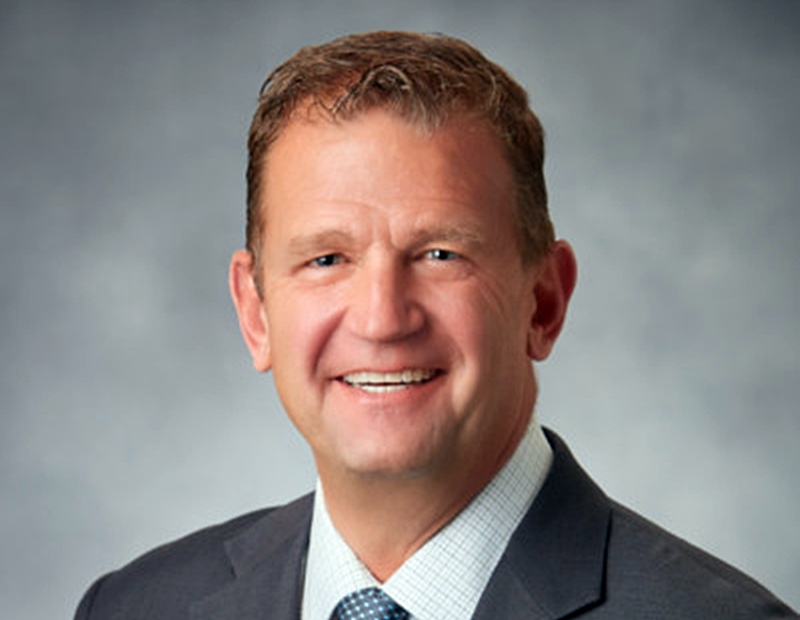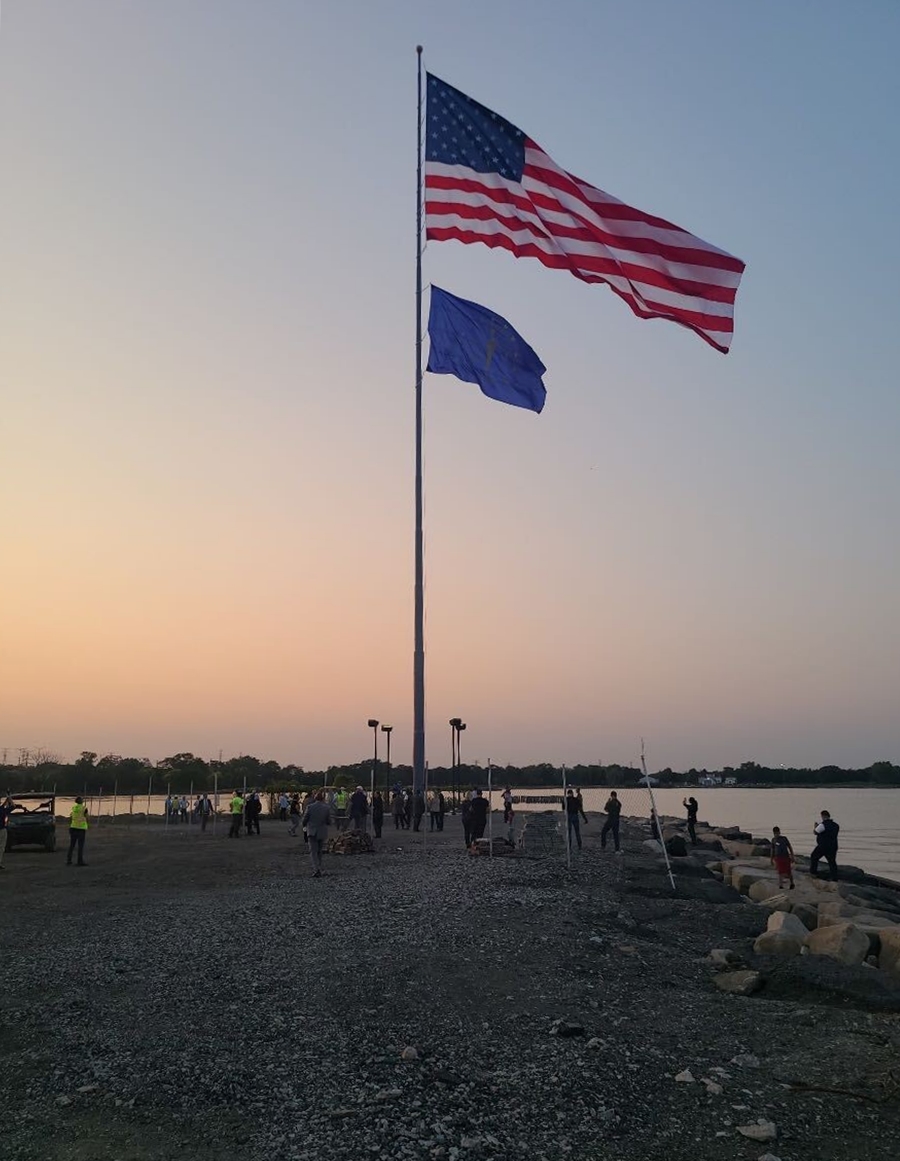Crossing the Road to the Digital Era
Digital Crossroad’s Thomas Dakich discusses why the company’s upcoming renewable energy data center is positioning the sector at the heart of the digital economy.
COVID-19 has spurred data center growth, creating new trends and reinforcing existing ones in property management, sustainability and construction. Among these are adaptive rehabilitations into modern facilities through private and public partnerships, such as the one between T5 Data Centers, Digital Crossroad and the state of Indiana. “We’re always looking for opportunities to transform distressed assets into state-of-the-art data centers that serve as the foundation for the digital economy,” Thomas Dakich, managing member of Digital Crossroad told Commercial Property Executive.
The company’s upcoming Data Center Campus in Hammond, Ind., is an example of creative conversion. The 1.7 million-square-foot project rises on the site of the former State Line Energy Plant, once considered the world’s largest electricity-producing generator. In the interview below, Dakich explains why the campus represents a new crossroads in industry and the way sustainable data center projects will transform Indiana into a next-generation digital landscape.
READ ALSO: Facebook to Build $800M Data Center in Metro Chicago
You are currently developing DXH-1, a 77-acre data center on the site of the former State Line Generating Plant. What can you tell us about this project?
Dakich: The public-private partnership between Digital Crossroad, Overwatch Mission Critical, Gov. Eric Holcomb, and Mayor Thomas McDermott and their respective economic development teams has resulted in the adaptive rehabilitation of the State Line Generating Plant, which was designed under the guidance of Thomas Edison and served as the source of electrical power for the Midwest for most of the 20th century.
The plant was decommissioned in 2012. Digital Crossroad is transforming this engineering marvel into a 21st century state-of-the-art data center campus that will boast 100 percent renewable energy availability and on-site solar power generation. There are five elements to the Digital Crossroad campus:
a. Mission-critical wholesale colocation data centers. The anchor of the campus will be more than 670,000 square feet and provide 100,000 megawatts of data center capacity. The first phase of the campus, DX-1, will open on Oct. 31 as a 105,000-square-foot building with access to 20 MW, of utility power.
b. Technology hub and incubator. When completed, the campus will include a 10,000-square-foot technology hub and incubator to foster and grow the local entrepreneurial base. The goal is to use this space in cooperation with local leaders such that the spirit of local thought is transformative. From Hammond, Ind., through Fort Wayne, Ind., there is a higher concentration of manufacturing jobs than anywhere else in the U.S. These congressional districts rely upon generations of labor for its direction. This tech hub and incubator is talking to the children of decades of labor and is also giving first-generation college-educated children a chance to see a technology future.
c. Purdue University Northwest smart greenhouse. This 4,000-square-foot smart greenhouse will be adjacent to the second building projected to be on the campus. The equipment housed in data centers emits a substantial amount of heat that is very high in carbon dioxide. Redirecting that heat into a greenhouse will make it much more efficient.
d. Alternative energy campus. The entire data center industry is driven toward alternative energy consumption. As the percentage of energy usage by data centers across the nation increases, the drive to reduce emissions has been embraced by the entire industry. The Digital Crossroad Data Center will be a leader in securing alternatives to coal consumption. We also have access to more than 912 million gallons of water per day, as much water as is available to almost any entity on Lake Michigan.
e. Largest flagpole in Chicagoland. On Sept. 11, the largest flagpole in the Chicagoland region was placed on the campus. At 164 feet, this landmark will anchor the Veteran’s Park.
An increasing number of developers are nowadays opting for adaptive reuses. However, this approach is rarely found in the data center sector. Were there any challenges you encountered along the way?
Dakich: Interestingly, the data center industry is one of the leaders in adaptive reuse projects. Brownfield development yields a number of advantages to data center developers and the surrounding communities.
This space surprisingly was not contaminated. Our challenge with this property was finding all the nuances to the former powerplant, but in managing those issues, we found new solutions. The ability to use the lake water in astronomically large volumes was discovered as part of the adaptive rehabilitation of the property. By checking the facility, we found new and creative ways to avoid energy consumption through our closed-loop cooling process.
By taking distressed assets, such as the State Line Generating Plant, we are able to transform a former polluting facility into a clean energy beacon for Northwest Indiana. This has obvious benefits for the people of Hammond and the greater Chicagoland market. In terms of challenges, we encountered competition from other adaptive reuse projects, such as multifamily residential development, and had to work closely with local and state officials to demonstrate the long-term benefits a healthy data center industry can bring to the Indiana economy.
The State Line Generating Plant placed Indiana at the crossroads of power generation for the Midwest. The Digital Crossroad Data Center campus will help Indiana regain the title as the crossroad to the cloud.
Your projects originate from a model of sustainability and social responsibility. Tell us more about the sustainable features they incorporate.
Dakich: The Digital Crossroad campus will incorporate a number of such features starting with the foundation of the data center itself. The State Line Generating Plant contained a massive amount of concrete and other construction materials destined for landfills and other nonenvironmentally friendly destinations. Every possible material that could be recycled properly and reused in any capacity was utilized. Despite the increased costs, the Digital Crossroad development team upcycled more than 300,000 cubic yards of recycled roadway and asphalt, 120,000 cubic yards of blast furnace aggregate and 100,000 cubic yards of concrete.
This effort kept over 100 acres of waste from reaching the landfill. In addition, we offer Green Choice power generation from a sensible combination of renewable sources such as wind, solar and through our energy partner NIPSCO.
NIPSCO has adopted a Your Energy, Your Future program to eliminate nearly all coal generation by 2023 and offer 100 percent renewable energy by 2028. Digital Crossroad customers can purchase as little as 5 percent or as much as 100 percent of their electricity from renewable generation. We are in the process of building an 800-kilowatt solar power generation plant on-site, a greenhouse that will utilize waste heat from the data center to grow crops and repurposing the State Line Archway Building as a tech incubator for local startups.
Digital Crossroad has selected T5 Data Centers to handle critical facility management services for its new data center campus in Hammond, Ind. Why did you choose this company and how has this partnership unfolded so far?
Dakich: With over 50 data centers spread across more than 20 global markets and a workforce of over 400 mission-critical professionals—60 percent of which are veterans—we believe T5 is the perfect partner to deliver the proven operational support our customers require. We are opening the first phase of the Digital Crossroad campus in October and T5 has been working side by side with our construction team as we progress into commissioning. Having T5 as part of the team, even before the data center is live, is key to our ability to ensure 24/7 operational readiness on day one.
READ ALSO: Data Centers See No Clouds Ahead
Tell us more about Indiana’s Data Center Gross Retail and Use Tax Exemption and the effects it has had on your projects.
Dakich: Indiana House Bill 1405, passed on in May 2019, establishes a sales and use tax exemption for the purchase of certain qualified data center equipment that is located in a data center that results in a minimum qualified investment within five years, ranging from at least $25 million to more than $150 million, depending on the population of the county in which the data center is located. It provides that certain other costs—such as those for tangible and intangible personal property, essential to the operations of a data center, excluding property used in the administration of the facility—are exempt from sales and use tax.
Further, it provides that the purchase of all electricity used by qualified data center equipment, excluding electricity used in the administration of the facility, is also exempt from sales and use tax. The bill requires a qualified data center user to apply to the Indiana Economic Development Corporation for a specific transaction award certificate and enter into an agreement with the IEDC as a condition of receiving an award certificate.
Basically, this is a blanket purchase exemption that applies to the Digital Crossroad project so each and every tenant and subtenant can participate with our approval. The customer would avail themselves of this by sharing a copy of Digital Crossroad’s award, corresponding resale certificate and form ST-105 (exemption form). After completion of the purchase and payment, Digital Crossroad will report the customer’s purchase to Indiana for record-keeping purposes against Digital Crossroad’s blanket award. We believe this exemption will offer our customers a significantly lower total cost of ownership compared to other data center markets, such as Chicago.
What are some other features that make Chicagoland a growing tech hub?
Dakich: The Chicagoland market is literally the crossroads of America. Starting in the 19th century, all transcontinental rail traffic traversed Indiana. Today, that railway infrastructure provides the foundation for a rich fiber-optic network that carries internet traffic between the East and West coasts.
In addition to being a key network hub, the Chicagoland market has access to major population centers and key financial institutions and carries a low risk of natural disasters, such as earthquakes and hurricanes. Indiana offers highly attractive economic advantages including a 0 percent sales and use tax for 50 years on data center investments.
How has the data center sector changed since the onset of the pandemic?
Dakich: The most recent JLL Data Center Industry Market Outlook highlights how the data center vertical is outperforming other sectors amid the pandemic. Data center real estate investment trusts outperformed other sectors due to immediate demand for e-commerce and virtual connectivity. These REITs recorded the highest year-to-date returns in the first half of 2020, ahead of office, industrial, retail, hospitality and health care.
Three out of five data center REITs recorded at least 40 percent returns over the past year. Available data center supply decreased in the first half of 2020 across every market. Regardless of the pandemic, the data center sector saw significant construction activity in the top five data center markets (Northern Virginia, Northern California, Phoenix, Dallas and Chicago) as operators struggled to maintain a steady stream of new inventory to keep up with demand spikes.
How do you see it going forward?
Dakich: We don’t believe there will be a return to the way things were. The pandemic has changed people’s behavior in a number of ways, including how we shop, conduct meetings, go to the doctor and attend school. Companies that had three-to-five-year transformation initiatives found those fast forwarded into a period of months. Digital transactions have replaced their analog counterparts across a variety of industries from automotive to health care. And since data centers house the compute, storage and network connectivity required to process these transactions, we believe our industry is well-positioned for the foreseeable future.










You must be logged in to post a comment.